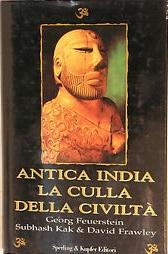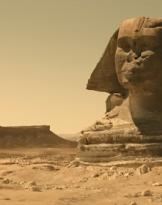Now, reading this book, I have discovered that, perhaps, the Indian texts that go under the collective name of "Veda" are even older, such as Sanskrit, the language used to write them. Of course, I would not put my hand in the fire. but the authors argue this with conviction.
Where does their conviction come from? Dai Veda.
The Vedas are sacred texts that according to the three authors were written in remote times. But how remote?
This is still to be understood, both because India has a very important oral tradition, and because the texts refer to a geography of India that in part no longer exists and finally because of the distortions due to the Eurocentric historical interpretations that have always denied to India the right position in the culture and history of the world.
The Vedas are the longest and most complex sacred texts in the world. The Rig-veda, the oldest, is a collection of 1028 hymns in praise of the Divine. Note well that I said of the Divine, in the singular, this because even though we commonly think that in India many gods are worshiped, these are nothing but different aspects of the same single divinity.
The second of the Vedas is called Sama-veda and is a liturgical textbook that largely recalls the hymns from the Rig-veda. The third text is Yajur-veda, or the text of sacrificial hymns. It seems to have been composed towards the end of the Vedic era. Finally there is the Atharva-veda, a particular and probably more recent text.
The sacred Veda texts are not the only ancient texts coming from India, to these we must add the Brahmanas, the Upanishads or the esoteric scriptures and the Aranyakas, texts destined for initiates. But, after giving general notes, you might ask me: what period are the texts we are talking about? Why do you tell us that they are probably the oldest in the world?
I must say that the book, from this point of view, is very interesting because it traces the history of the studies made on the texts reporting the different hypotheses advanced over time on the antiquity of Vedic texts and on the ancient history of India itself.
One of the things that struck me most is the theory of the Aryan invasion of India. In short it is a hypothesis put forward by some European scholars, mainly Max Muller and Gordon Childe, who by linking the use of language to the Aryan ethnic group inadvertently addressed scholars in thinking that a North European people, Aryan precisely, they had invaded India in former times and from this invasion Indian culture was born. The evidence in favor of the advanced hypothesis was practically nil but the political situation of Europe in the late nineteenth and early twentieth centuries was such that the hypothesis soon became truth and was used, among other things, to justify the superiority of the Aryan race on the rest of the world.
And to say that the term Ariano, which derives from the Sanskrit Arya, meant in ancient India "noble", "educated"! What a joke.
But let's go back for a moment to things taken for granted.
Most people assume that the evolution of human society is linear. From animals we have become men beginning to cultivate the land, grouping in villages near the rivers. Well-administered villages grew into cities ... and so we arrive today.
Yet things are not so simple and linear.
How many times has an earthquake, a tsunami or an epidemic rejected man at a previous stage of development? We cannot know, but it has certainly happened.
In the far east the discovery of different cities dated at least to 2000 BC confirm the fact that history proceeds with sobs and that even very advanced cultures can regress and disappear altogether.
Harappa, Mohenjo Daro, Kalibangan and many other sites that were discovered in the early twentieth century, show that there were cities in the distant past, cities that disappeared when, probably due to enormous earth upheavals, a river to the east of the Indus disappeared, leaving space for a huge almost desert plain. This river that has passed away is probably the river itself mentioned in Rig-veda, the Sarasvati, now hidden under the sands of the Thar desert. Yet if anyone had used the information reported in Rig-veda, as Schliemann did for his search for Troy, they would have allowed them to find cities and treasures where they are actually nowadays.
If this was the case, we must begin to think that the Vedas were composed before the upheavals that caused the Sarasvati to disappear. If this were true, the Vedas would really be the oldest texts in the world!
So, around the 2000 BC (or before!), Upsetting immensely changed the face of the earth in the territory of India, erasing entire rivers and populations. A question, is it possible that these upheavals have left the rest of the world unharmed?
I do not know, but it seems strange to me that such upheavals can happen without the rest of the world being influenced by it.
However it went, one thing I can say with certainty, in my list of books to read, the Vedas have won a priority position. In my library I have already reserved a place of honor, next to "Ancient India, the cradle of civilization".
Alessandro Rugolo












